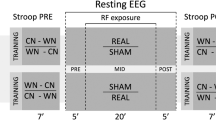Abstract
In the past, many studies have claimed that extremely low frequency (ELF) magnetic field (MF) exposures could alter the human electroencephalographic (EEG) activity. This study aims at extending our ELF pilot study to investigate whether MF exposures at ELF in series from 50, 16.66, 13, 10, 8.33 to 4 Hz could alter relative power within the corresponding EEG bands. 33 human subjects were tested under a double-blind and counter-balanced conditions. The multiple repeated three-way analysis of variance (ANOVA) mixed design (within and between-subject) analysis was employed followed by post-hoc t-tests and Bonferroni alpha-correction. The results from this study have shown that narrow alpha1 (7.5–9.5 Hz) and alpha2 (9–11 Hz) bands, associated with 8.33 and 10 Hz MF exposures, were significantly (p < 0.0005) lower than control over the temporal and parietal regions within the 10–16 min of first MF exposure session and the MF exposures were significantly higher than control of the second session MF exposure (60–65 min from the commencement of testing). Also, it was found that the beta1 (12–14 Hz) band exhibited a significant increase from before to after 13-Hz first MF exposure session at frontal region. The final outcome of our result has shown that it is possible to alter the human EEG activity of alpha and beta bands when exposed to MF at frequencies corresponding to those same bands, depending on the order and period of MF conditions. This type of EEG synchronisation of driving alpha and beta EEG by alpha and beta sinusoidal MF stimulation, demonstrated in this study, could possibly be applied as therapeutic treatment(s) of particular neurophysiological abnormalities such as sleep and psychiatric disorders.






Similar content being viewed by others
References
Azanza MJ, Calvo AC, Moral AD (2002) Evidence of synchronisation of neural activity of molluscan brain ganglia induced by alternating 50 Hz applied magnetic field. Electromagn Biol Med 21(3):209–220
Bell GB, Marino AA, Chesson A, Struve FA (1991) Human sensitivity to weak magnetic fields. Lancet 338:1521–1552
Bell GB, Marino AA, Chesson A (1994) Frequency-specific responses in the human brain caused by electromagnetic fields. J Neurol Sci 123:26–32
Cook CM, Thomas AW, Prato FS (2002) Human electrophysiological and cognitive effects of exposure to ELF magnetic and ELF modulated RF and microwave fields: a review of recent studies. Bioelectromagnetics 23:144–157
Cook CM, Thomas AW, Prato FS (2004) Resting EEG is affected by exposure to a pulsed ELF magnetic field. Bioelectromagnetics 25:196–203
Cook CM, Thomas AW, Keenliside L, Prato FS (2005) Resting EEG effects during exposure to a pulsed ELF magnetic field. Bioelectromagnetics 26:367–376
Cvetkovic D (2005) Electromagnetic and audio-visual stimulation of the human brain at extremely low frequencies. PhD Thesis, RMIT University, Melbourne, Australia
Cvetkovic D, Cosic I (2006) Automated ELF magnetic field stimulation of the human EEG activity. Integr Comput Aided Eng 13(4):313–328
Cvetkovic D, Cosic I (2007) Modelling and design of extremely low frequency uniform magnetic field exposure apparatus for in vivo bioelectromagnetic studies. In: Proceedings of the 29th annual international conference IEEE engineering in medicine and biology society (EMBS), Lyon, France, pp 1675–1678
Cvetkovic D, Cosic I (2009) EEG inter/intra-hemispheric coherence and asymmetric responses to visual stimulations. Med Biol Eng Comput. doi:10.1007/s11517-009-0499-z
Ghione S, Seppia CD, Mezzasalma L, Bonfiglio L (2006) Effects of 50 Hz electromagnetic fields on electroencephalographic alpha activity, dental pain threshold and cardiovascular parameters in humans. Neurosci Lett 382:112–117
Griefahn B, Kunemund C, Blaszkewicz M, Golka K, Degen G (2002) Experiments on effects of an intermittent 16.7-Hz magnetic field on salivary melatonin concentrations, rectal temperature and heart rate in humans. Int Arch Occup Environ Health 75:171–178
Hausser K, Tellschaft D, Thoss F (1997) Influence of an alternating 3 Hz magnetic field with an induction of 0.1 mT on chosen parameters of the human occipital EEG. Neurosci Lett 239:57–60
Lyskov EB, Juutilainen J, Jousmaki V, Partanen J, Medvedev S, Hanninen O (1993) Effects of 45-Hz magnetic fields on the functional state of the human brain. Bioelectromagnetics 14:87–95
Marino AA, Bell GB, Chesson A (1996) Low-level EMFs are transduced like other stimuli. J Neurol Sci 144:99–106
Marino AA, Nilsen E, Chesson AL Jr, Frilot C (2004) Effect of low-frequency magnetic fields on brain electrical activity in human subjects. Clin Neurophysiol 115:1195–1201
Paus T, Sipila PK, Strafella AP (2001) Synchronisation of neuronal activity in the human primary motor cortex by transcranial magnetic stimulation: an EEG study. J Neurophysiol 86(4):1983–1990
Podd JV, Whittington CJ, Barnes GRG, Page WH, Raply BI (1995) Do ELF magnetic fields affect human reaction time. Bioelectromagnetics 16:317–323
Sastre A, Graham C, Cook MR (2000) Brain frequency magnetic fields alter cardiac autonomic control mechanisms. Clin Neurophysiol 111:1942–1948
Stevens P (2006) Affective response to 5 μT ELF magnetic field-induced physiological changes. Bioelectromagnetics 28(2):109–114
Thomas AW, Kavaliers M, Prato FS, Ossenkopp KP (1997) Antinociceptive effects of pulsed magnetic fields in the land snail: Cepaea nemoralis. Neurosci Lett 222:107–110
Whittington CJ, Podd JV (1996) Human performance and physiology: a statistical power analysis of ELF electromagnetic field research. Bioelectromagnetics 17:274–278
Acknowledgement
The authors gratefully acknowledge the financial support received from the Australian NHMRC to the Australian Centre for Radio Frequency Bioeffects Research (ACRBR) which has assisted this research study.
Author information
Authors and Affiliations
Corresponding author
Rights and permissions
About this article
Cite this article
Cvetkovic, D., Cosic, I. Alterations of human electroencephalographic activity caused by multiple extremely low frequency magnetic field exposures. Med Biol Eng Comput 47, 1063–1073 (2009). https://doi.org/10.1007/s11517-009-0525-1
Received:
Accepted:
Published:
Issue Date:
DOI: https://doi.org/10.1007/s11517-009-0525-1




